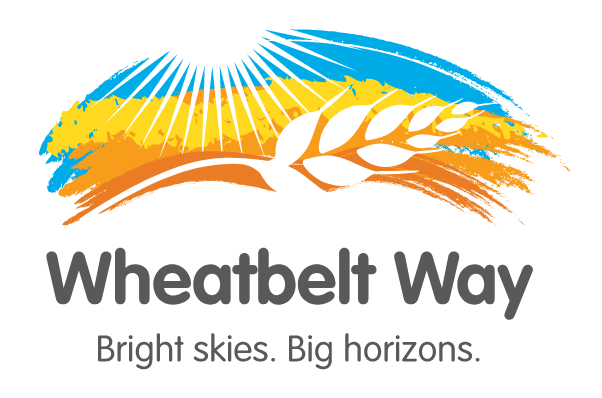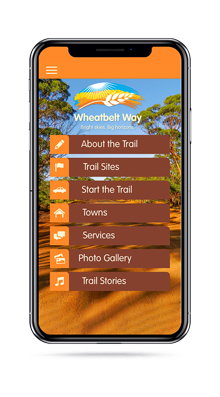FAQs
The first point of contact for further information regarding the places and experiences around the Wheatbelt Way Drive should be one of the Visitor Information Centres located throughout the drive. These are the best places to obtain up-to-date information about road conditions and services like fuel and accommodation. For enquiries concerning the group tours to the Wheatbelt Way, website, media, marketing, or of a general nature please complete the form on the Contact Us page or send an email directly to contact@wheatbeltway.com.au
Diesel and ULP are readily available in all towns across the Wheatbelt Way. Specific information can be found here. There is no LPG available across the Wheatbelt Way.
The majority of the Wheatbelt Way Drive trail is along sealed bitumen roads with stretches of good unsealed gravel roads that are generally in good condition and then road to track access for rock and bushland attractions. The trail is suitable for all 2WD vehicles and nearly all sites and attractions are accessible for cars towing caravans/camper trailers.
Unless you have access to Satellite TV or VAST setup you will not be able to access digital television through a DigitalReady Setup (TV or Set Top Box) in the following towns; Beacon, Bencubbin, Trayning, Mukinbudin, Nungarin, Westonia and Wyalkatchem.
Mobile Phone coverage in some parts of the Wheatbelt Way region is limited. BUT all of the Wheatbelt Way towns will have good mobile phone access. Please be aware Telstra 3G/4G is the only service provider throughout the Wheatbelt Way, other service providers will have very limited or no coverage outside the capital city of Perth, to get a better idea view this map. It is recommended that if you are not with Telstra as your mobile phone service provider that you purchase a Telstra SIM card for your Wheatbelt Way Road Trip.
The Wheatbelt Way welcomes responsible dog owners to our region. Dogs are welcome at a range of accommodations but please remember that it is up to the Owner’s/Managers discretion if and when pets are allowed – please do not hesitate to phone ahead and ask. Dogs are also welcome at the free campgrounds except for Elachbutting Rock. We have put together a Pet-Friendly Guide to help you in planning your trip. Dogs must be supervised at all times and not be left unattended. Dogs are also not allowed at Sandford Rocks, Billyacatting Hill Nature Reserve, and Korrelocking Reserve.
Visitors to the Wheatbelt Way are requested to bring their own firewood with them when camping at Wheatbelt Way Sites, as firewood at these locations is sparse. The use of chainsaws is prohibited and vegetation and infrastructure are not to be removed for the purpose of firewood for campfires.
Campfire and Firewood Guidelines:
a. Bring firewood with you from home.
b. Light fires only in the fireplaces provided where possible.
c. Ensure the area around your campfire is cleared of all flammable material for a distance of at least 3m.
d. Ensure fires are never left unattended and are completely out before you leave.
e. Gernerally from November to February a Prohibited Burning Period is in place across the entire Wheatbelt Way, NO fires including cooking and campfires are permitted during this time.
Open air Camping and Cooking fires are also not permitted in Wheatbelt Way Shire areas during each Shire’s gazetted ‘Prohibited and Restricted Burning Times‘ unless you have a Fire Permit.
Restricted burning periods in the region generally start being implemented from around mid-September to early October in the region. It is highly recommended that you check with each of the Wheatbelt Way local governments as to their restricted burning period dates each year and process for applying for a Fire Permit.
A Prohibited burning period is generally in place from 1 November to 31 January, there are to be NO camping and cooking fires.
During the summer months, when bushfires are a very real danger, a total fire ban may be declared. On these days, people are not permitted to light any fires whatsoever including lighting a fuel stove or BBQ. For information about locations of current total fire bans call 1800 709 355 or visit the DFES Alerts webpage.
The best time to visit the Wheatbelt Way is from July-October. The weather is mild, generally with warm days and cool nights. With good winter rains the landscapes will offer stunning panoramas and the wildflowers will be at their best during this time.
There are 13 free campsites across the Wheatbelt Way. Each campsite has a designated camping area with fire pits, picnic tables and composting toilets. For more information check out the Camp Sites page.
There are three ATMs in the region; one is located in Bencubbin, Koorda and Mukinbudin, these are located on the outside of the buildings and are available 24/7. Most Australia Post outlets offer cash out services (fees apply) in business hours Monday – Friday. Many businesses will allow cash out though EFTPOS if you have purchased something at their business. It is generally a good idea to bring some cash out with you on your visit.
No. Unfortunately there are no public buses or taxis available across the Wheatbelt Way. The best way to see our region is to self-drive in your own vehicle. From time to time private tour companies do offer Wildflower tours through our region.
The wildflower season generally commences in the north of our region in August and finishes by the end of September. But before you begin your journey, check our wildflower page, latest website blogs for current information and/or call into the local visitor centre for information about the variety and location of wildflowers in bloom. Although Western Australian wildflowers can often be seen from the roadside, many interesting species can be found a short distance off the road or at local reserves and the local visitor centers will be happy to point you in the right direction for the best local spots!



